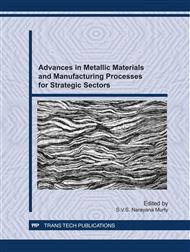[1]
K.G. Keong, W. Sha, S Malinov, Crystallisation kinetics and phase transformation behaviour of electroless nickel-phosphorus deposits with high phosphorus content, J. of Alloys and Comp. 334 (2002) 192-199.
DOI: 10.1016/s0925-8388(01)01798-4
Google Scholar
[2]
T.S.N. Sankara Narayanan, I. Bhaskaran, K. Krishnaveni, S Parthiban, Deposition of electroless Ni-P graded coatings and evaluation of their corrosion resistance, Surf. and Coatings Technology 200 (2006) 3438-3445.
DOI: 10.1016/j.surfcoat.2004.10.014
Google Scholar
[3]
G.O. Mallory, J.B. Hajdu (Eds) Electroless Plating and Applications, AESF, Orlando, 1991.
Google Scholar
[4]
W. Riedel, Electroless Plating, ASM International, Ohio, 1991.
Google Scholar
[5]
D.W. Bandrand, Electroless nickel plating, Surface engineering ASM Handbook, Vol. 5, American Society for Materials, Materials Park, Ohio, 1994.
Google Scholar
[6]
M.M. Younan, S.A. Abo El-Enine, Electroless deposition of Nickel-Copper-Phosphorous alloy on Aluminium, Galvanotechnik, 102 (2004) 2876-2881.
Google Scholar
[7]
E.L. Roy, J.G. Kaufman, Aluminium alloy castings-Properties, processes and applications, ASM International, Materials Park, Ohio, 2004.
Google Scholar
[8]
S.S. Tulsi, Properties of electroless nickel, Trans. of the Institute of Metal Finishing, 64 (1996) 73-76.
Google Scholar
[9]
N.M. Martyak, S. Wetterer, L. Harrison, M. McNeil, Annealing behaviour of electroless coating, 92 (1994) 111-116.
Google Scholar
[10]
E.M. Ma, S.F. Luo, P.X. Li, Transmission electron microscopy study on the crystallization of amorphous Ni-P electroless deposited coatings, Thin Solid Films 166 (1988) 511-520.
DOI: 10.1016/0040-6090(88)90388-4
Google Scholar
[11]
R.C. Agarwala, S. Ray, Vibration structure in electroless Ni-P films with phosphorous content, Z. Metallkd, 79 (1988) 472-475.
Google Scholar
[12]
Su Hoon Park, Dong Nyung Lee, A study on the microstructure and phase transformation of electroless nickel deposits, J. of Mater. Sci., 23 (1988) 1643-1654.
DOI: 10.1007/bf01115703
Google Scholar
[13]
P.S. Kumar, P.K. Nair, Studies on crystallization of electroless Ni-P deposits, J. of Mater. Proc. Tech., 56 (1996) 511-520.
Google Scholar
[14]
J.N. Balaraju, K.S. Rajam, Electroless deposition and characterisation of high phosphorous Ni-P-Si3N4 composite coatings, Int. J. Electrochem. Sci., 2 (2007) 747-761.
Google Scholar
[15]
A. Malecki, A. Micek-Ilnicka, Electroless nickel plating from acid bath, Surf. and Coat. Tech., 123 (2000) 72-77.
DOI: 10.1016/s0257-8972(99)00423-5
Google Scholar


